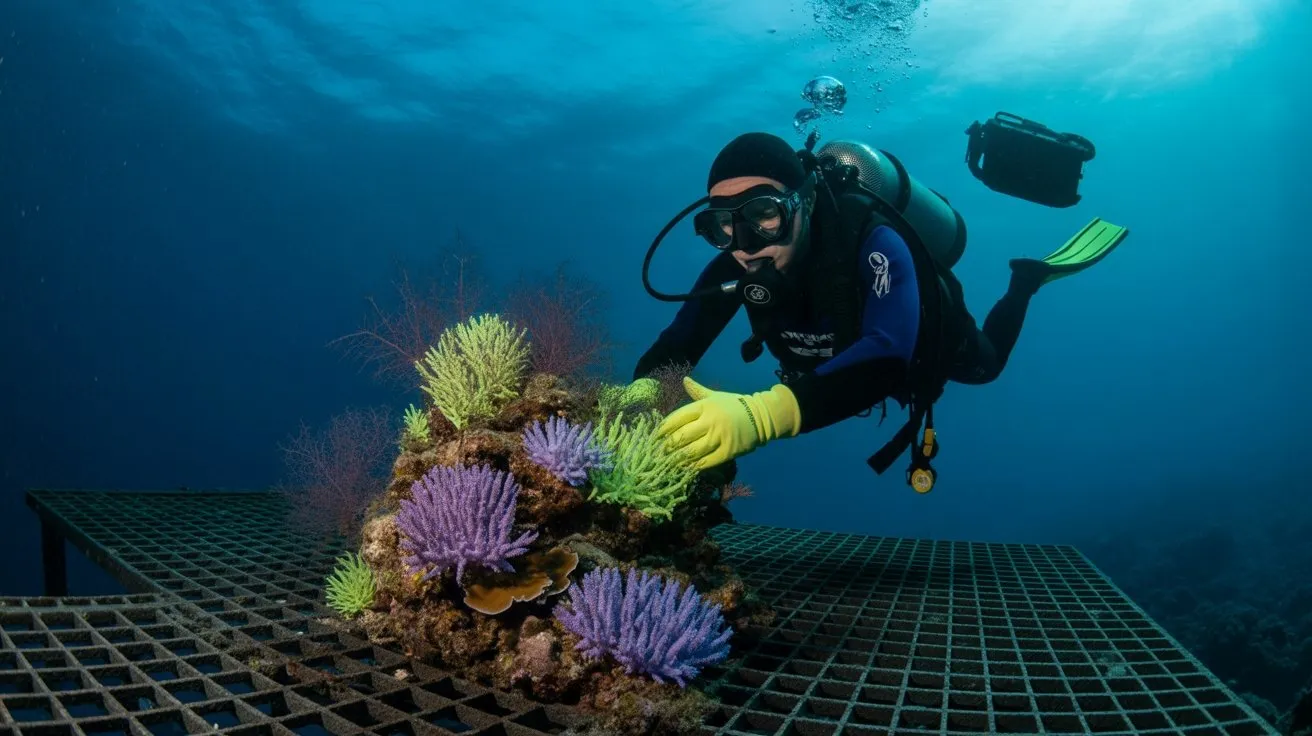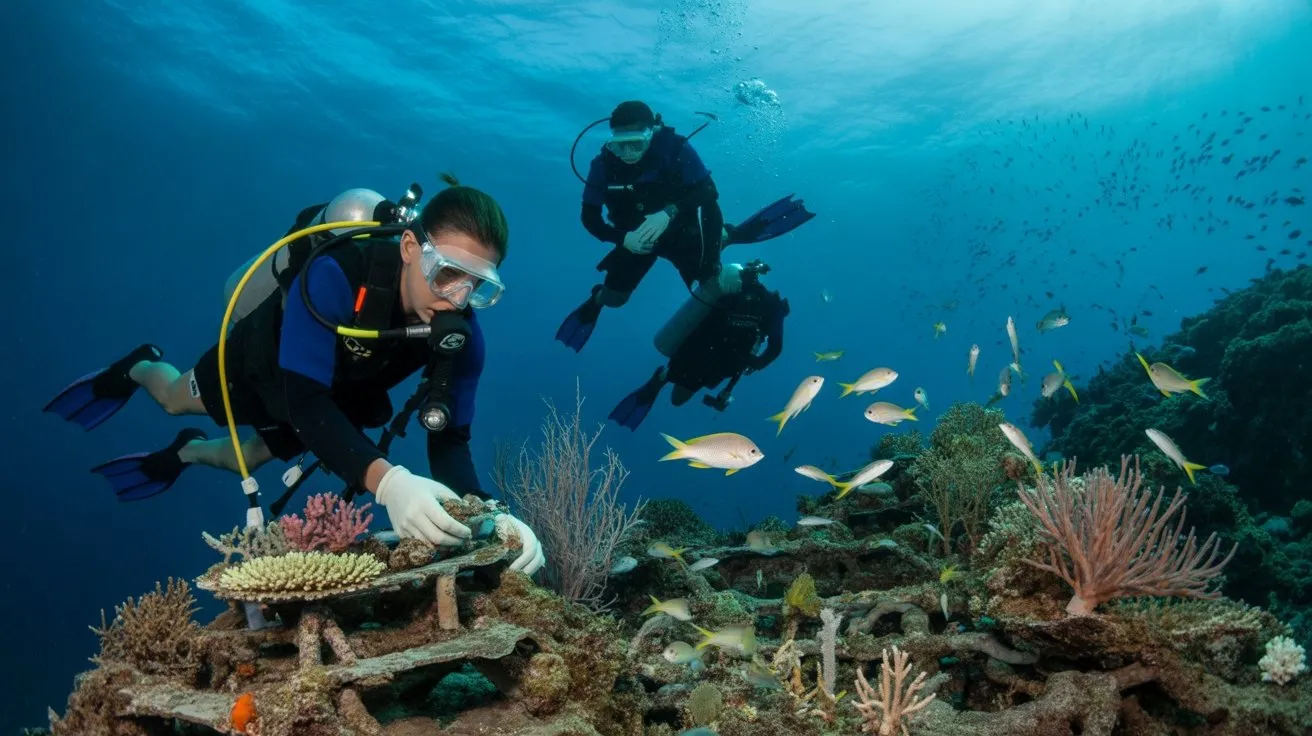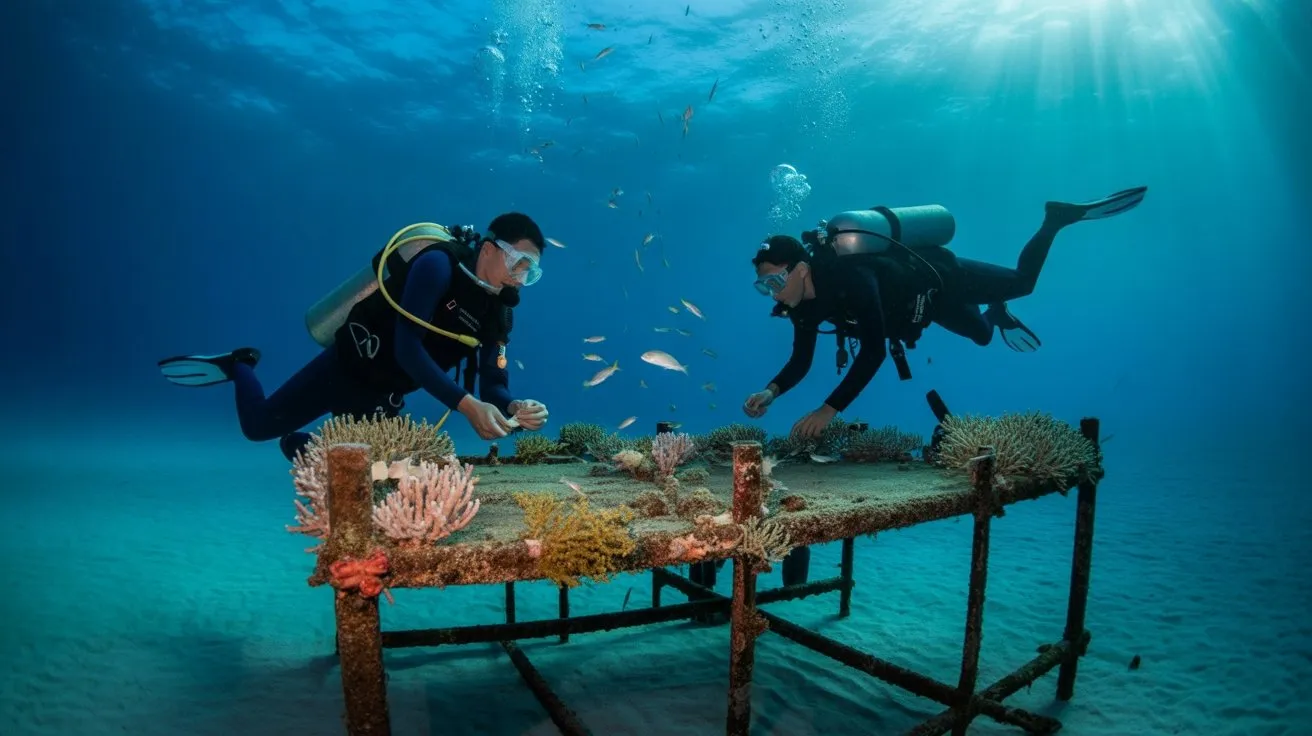Like underwater architects rebuilding a fallen city, you’re witnessing marine scientists reconstruct coral ecosystems through precision-engineered restoration protocols. You’ll discover how researchers achieve 70-90% survival rates using fragmentation techniques and thermal conditioning in controlled nursery environments. Heat-resistant coral phenotypes developed through selective breeding now demonstrate 40% greater bleaching tolerance at elevated temperatures. These data-driven interventions represent humanity’s most sophisticated attempt to reverse decades of reef degradation, but the true measure of success lies in factors you haven’t yet considered.
The Science Behind Coral Bleaching and Reef Degradation
When ocean temperatures rise just 1-2°C above normal seasonal maximums, you’re witnessing the trigger for mass coral bleaching events that have devastated approximately 50% of shallow-water corals globally since the 1980s.
You’ll find that stressed corals expel their symbiotic zooxanthellae algae, losing their primary nutrition source and vibrant coloration.
Ocean acidification compounds this crisis—you’re seeing pH levels drop 0.1 units since pre-industrial times, reducing carbonate ion availability by 16%. This impairs coral calcification rates and weakens skeletal structures.
Additional stressors you can identify include nutrient pollution, sedimentation, and physical damage from coastal development.
Without intervention, you’re facing projected losses of 70-90% of warm-water corals under current warming scenarios. Urgent action is required to preserve coral reefs for future generations as their health is essential for the long-term stability of marine ecosystems.
Underwater Nurseries: Growing Coral Fragments for Transplantation

While traditional reef restoration once relied on protecting existing coral populations, you’re now seeing marine biologists revolutionize recovery efforts through sophisticated underwater nursery systems that propagate coral fragments at unprecedented scales. These floating tree-like structures suspend coral fragments 15-30 feet above degraded reef sites, optimizing growth conditions through enhanced water circulation and reduced sedimentation exposure. Healthy reefs contribute to coastal protection and biodiversity, making these restoration methods critical for marine ecosystems.
| Nursery Type | Growth Rate | Survival Rate | Deployment Depth | Species Compatibility |
|---|---|---|---|---|
| Tree Nurseries | 25-50cm/year | 85-95% | 15-30 feet | Staghorn, Elkhorn |
| Table Nurseries | 15-35cm/year | 80-90% | 20-40 feet | Brain, Star corals |
| Rope Nurseries | 20-40cm/year | 75-85% | 10-25 feet | Branching species |
| Micro-fragmentation | 50x faster | 90-98% | Laboratory/Field | All hard corals |
| Fusion Techniques | 25-100x faster | 85-95% | Controlled settings | Compatible genotypes |
You’ll find these nurseries achieve 6-12 month cultivation cycles before successful transplantation to restoration sites.
Heat-Resistant Coral Development Through Selective Breeding

As ocean temperatures continue rising beyond coral tolerance thresholds, you’re witnessing marine geneticists develop breakthrough selective breeding programs that identify and propagate thermally resilient coral genotypes.
These initiatives target corals surviving temperature stress events exceeding 29°C for extended periods. Scientists collect gametes from heat-tolerant parent colonies, cross-fertilize specimens showing enhanced symbiodinium algae partnerships, then rear offspring under controlled thermal stress conditions.
Data indicates second-generation corals demonstrate 2-4°C increased bleaching thresholds compared to wild populations.
You’ll find research stations conducting accelerated evolution protocols, exposing coral fragments to gradual temperature increases over multiple reproductive cycles. This assisted gene flow approach produces populations with enhanced thermotolerance while maintaining genetic diversity essential for ecosystem resilience against climate change impacts. Furthermore, these efforts contribute to the overall biodiversity of coral reefs, supporting habitats for various marine species.
Coral Gardening and Direct Transplantation Methods

Beyond laboratory-based breeding programs, marine restoration specialists implement direct coral gardening techniques that accelerate reef recovery through strategic fragment cultivation and transplantation. You’ll observe scientists establishing coral nurseries where they fragment colonies into 2-5cm pieces, creating ideal growth conditions through strategic positioning and monitoring. These fragments demonstrate remarkable regenerative capacity, achieving 3-10x faster growth rates than natural colonies. When you examine transplantation protocols, you’ll find success rates ranging from 60-85% depending on species selection and site conditions. Restoration teams utilize ceramic substrates and concrete frameworks to secure transplants, creating complex three-dimensional structures. Critical factors you’ll monitor include water temperature (26-29°C), pH levels (8.1-8.3), and nutrient concentrations. This approach typically yields 200-500 new colonies per hectare annually, establishing sustainable breeding populations that enhance genetic diversity and ecosystem resilience. Additionally, coral reefs play a crucial role in supporting diverse marine species, further highlighting the importance of these restoration efforts.
Technology-Driven Restoration: 3D Printing and Artificial Reef Structures

Though traditional coral cultivation remains effective, marine engineers now employ advanced 3D printing technologies to construct calcium carbonate reef frameworks that precisely replicate natural coral architecture.
You’ll find these biorock structures accelerate coral settlement rates by 40-60% compared to flat substrates. Scientists utilize CT scans of healthy coral formations to design complex geometries with optimized surface area-to-volume ratios.
The printed substrates incorporate pH-neutral materials that won’t disrupt local water chemistry. You can deploy these artificial frameworks at depths ranging from 3-30 meters, where they serve as recruitment sites for planktonic coral larvae. Additionally, the success of these projects highlights the resilience and adaptability of life in extreme conditions, similar to species found around hydrothermal vents.
Current projects in the Caribbean demonstrate 85% coral survival rates on 3D-printed substrates after 18 months. This technology-driven approach enables rapid deployment across degraded reef systems while maintaining structural complexity essential for marine biodiversity.
Community-Based Restoration Programs Around the World
Cutting-edge technology addresses only part of coral restoration’s complex challenges, while grassroots conservation initiatives worldwide demonstrate that local communities drive the most sustainable and scalable reef recovery programs.
You’ll find successful models in Fiji’s Tabu system, where villages establish 20-30% no-take zones, resulting in 50% coral cover increases within five years.
Indonesia’s Reef Check Foundation trains 2,000+ local monitors annually, achieving 83% fragment survival rates through community-managed nurseries.
You can observe similar success in Mexico’s Mesoamerican Reef, where fishing cooperatives transplant 15,000 coral fragments yearly while maintaining 92% stakeholder participation.
These programs prove that combining traditional ecological knowledge with scientific methodology creates restoration initiatives that persist beyond funding cycles, generating measurable biodiversity recovery. Additionally, Marine Protected Areas have been shown to enhance the effectiveness of such community-based efforts by providing safe habitats for coral recovery.
Measuring Success: Monitoring and Long-Term Outcomes of Restoration Efforts

While community engagement drives restoration success, you’ll need robust monitoring protocols to evaluate whether these efforts translate into measurable ecosystem recovery. Key metrics include coral survival rates, growth rates, recruitment densities, and species diversity indices.
You’ll track these parameters across multiple temporal scales—monthly survival assessments, annual growth measurements, and decadal biodiversity analyses. Successful restoration demonstrates 70-90% fragment survival rates within two years, with growth rates exceeding 10cm annually for branching species.
You’ll measure recruitment success through juvenile coral densities and genetic diversity maintenance. Long-term outcomes require monitoring fish assemblages, invertebrate communities, and ecosystem function indicators like calcification rates. Additionally, the focus on marine conservation efforts is essential to ensure that restored reefs can thrive sustainably in their environments.
Remote sensing technologies, underwater photogrammetry, and environmental DNA sampling enhance monitoring efficiency. These data-driven approaches guarantee restoration investments yield quantifiable conservation benefits and adaptive management strategies.
Conclusion
You’re witnessing coral reefs emerge as phoenix-like beacons of hope through cutting-edge restoration technologies. As you deploy microfragmentation techniques and thermal-resilient genotypes, you’re literally engineering ecosystem resurrection. Each transplanted fragment represents a cellular promise—survival rates exceeding 85% in ideal nursery conditions. You’re not just rebuilding calcium carbonate structures; you’re weaving life’s tapestry back together. Through adaptive management protocols and community stewardship, you’re transforming bleached graveyards into vibrant underwater metropolises, ensuring biodiversity’s future.





